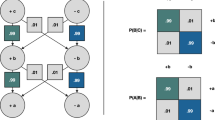Abstract
In 2005 the author introduced networks which allow attacks on attacks of any level. So if a → b reads a attacks b, then this attack can itself be attacked by another node c. This attack itself can attack another node d. This situation can be iterated to any level with attacks and nodes attacking other attacks and other nodes.
In this paper we provide semantics (of extensions) to such networks. We offer three different approaches to obtaining semantics.
-
1.
The translation approach
This uses the methodology of ‘Logic by translation’. We translate faithfully the new networks into ordinary Dung networks with more nodes and extract the semantics from the translation.
-
2.
The labelling approach
This method regards the arrows as additional entities to be attacked and to mount attacks and applies a variation of the usual machinery of Camindada like labelling to the network. The new concept we need to employ here is that of ‘joint attacks’.
-
3.
The logic programming approach
We translate the higher level network into a logic program and obtain semantics for it through known semantics for logic programs.
We then compare our methods with those of S. Modgil and P. M. Dung et al.
Similar content being viewed by others
References
Baroni, P., F. Cerutti, M. Giacomin, and G. Guida, ‘Encompassing attacks to attacks in abstract argumentation frameworks’, ECSQARU 2009, LNAI 5590, Springer, 2009, pp. 83–94.
Barringer, H., D. M. Gabbay, and S. Modgil, ‘Modal and Temporal Argumentation Networks’. To appear.
Barringer, H., D. M. Gabbay, and J. Woods, ‘Temporal Dynamics of Argumentation Networks’, in D. Hutter and W. Stephan (eds.), Volume Dedicated to Joerg Siekmann, Mechanising Mathematical Reasoning, Springer Lecture Notes in Computer Science 2605, 2005, pp. 59–98.
Bench-Capon, T., and S. Modgil, ‘Case Law in Extended Argumentation Frameworks’, in ICAIL’09: Proceedings of the 12th International Conference on Artificial Intelligence and Law, Barcelona, Spain, ACM, New York, 2009, pp. 118–127. IJAIL 08.
Boella, G., D.M. Gabbay, L. van der Torre and S. Villata, ‘Meta-Argumentation, part 1.’, Studia Logica, 93(2-3): 297–355, 2009, this issue.
Boella, G., D.M. Gabbay, L. van der Torre and S. Villata, ‘Argumentation Networks with Voluntary Attacks’, in preparation.
Caminada M., Gabbay D.M.: ‘A logical account of formal argumentation’. Studia Logica 93(2-3), 109–145 (2009)
Caminada M., Gabbay D.M.: ‘Embedding logic programs in argumentation framework’. Studia Logica 93(2-3), 383–403 (2009) this issue
Gabbay D.M.: ‘Fibring Argumentation Frames’. Studia Logica 93(2-3), 231–295 (2009) this issue
Gabbay D.M.: ‘Modal Provability Foundations for Argumentation Networks’. Studia Logica 93(2-3), 181–198 (2009) this issue
Gabbay D. M., ‘Semantics for higher level attacks in extended argumentation frames’, part 2.
Gabbay D.M., d’Avila Garcez A.S.: ‘Logical modes of attack in argumentation networks’. Studia Logica 93(2-3), 199–230 (2009) this issue
Gabbay D.M., Szałas A.: ‘Annotation theories over graphs’. Studia Logica 93(2-3), 147–180 (2009) this issue
Hanh, Do Duc, Phan Minh Dung, and Phan Minh Thang, ‘Inductive Defense for Modgil’s Extended Argumentation Framework’. Submitted to Journal of Logic and Computation.
Modgil S.: ‘Reasoning about preferences in argumentation frameworks’. Artificial Intelligence 173(9-10), 901–934 (2009)
Modgil, S., and T. Bench-Capon, ‘Integrating Object and Meta-level Value Based Argumentation’, Proceedings of the 2nd International Conference on Computational Models of Argument, 2008, pp. 240–251. Expanded version available at: http://www.csc.liv.ac.uk/research/techreports/tr2009/tr09019abs.html
Nielsen, S. H., and S. Parsons, a Generalization of Dung’s Abstract Framework for Argumentation: Arguing with Sets of Attacking Arguments, LNCS Vol 4766, Springer, 2007, pp. 54–73.
Author information
Authors and Affiliations
Corresponding author
Rights and permissions
About this article
Cite this article
Gabbay, D.M. Semantics for Higher Level Attacks in Extended Argumentation Frames Part 1: Overview. Stud Logica 93, 357 (2009). https://doi.org/10.1007/s11225-009-9211-4
Published:
DOI: https://doi.org/10.1007/s11225-009-9211-4




